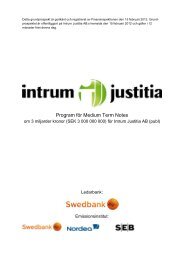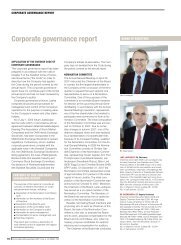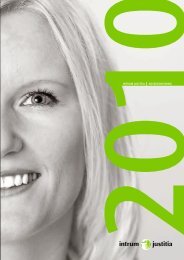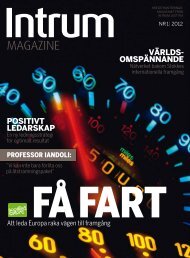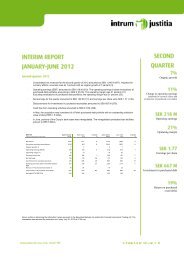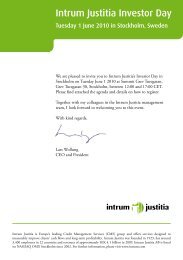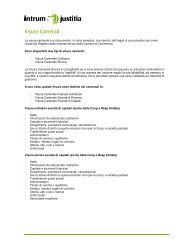ANNUAL REPORT INTRUM JUSTITIA A N N U A L R EP O R T 2 0 ...
ANNUAL REPORT INTRUM JUSTITIA A N N U A L R EP O R T 2 0 ...
ANNUAL REPORT INTRUM JUSTITIA A N N U A L R EP O R T 2 0 ...
Create successful ePaper yourself
Turn your PDF publications into a flip-book with our unique Google optimized e-Paper software.
Legal outlays<br />
The Group incurs outlays for court fees, legal representation,<br />
bailiffs, etc., which can be charged<br />
to and collected from debtors. In certain cases<br />
Intrum Justitia has agreements with its clients<br />
where any expenses that cannot be collected from<br />
debtors are instead refunded by the client. The<br />
amount that is expected to be recovered from a<br />
solvent counterparty is recognized as an asset in<br />
the balance sheet on the line, Other receivables.<br />
Client funds<br />
Client funds, which are reported as assets and<br />
liabilities in the balance sheet, represent cash received<br />
on collection of a specific debt on behalf of<br />
a client and payable to the client within a specified<br />
period. Client funds are liquid funds with a<br />
restricted disposition right. The same amount is<br />
reported as a liability.<br />
Liquid assets<br />
Liquid assets include cash and cash equivalents<br />
as well as immediately available balances with<br />
banks and similar institutions. Short-term investments<br />
consist of investments with an insignificant<br />
risk of fluctuating in value, which can<br />
easily be converted to cash and have a maturity<br />
of not more than three months from acquisition.<br />
Liabilities<br />
Liabilities are classified as other financial liabilities,<br />
which means that they are initially recognized<br />
at the amount received after deducting<br />
transaction expenses. Subsequent to acquisition,<br />
loans are carried at amortized cost according to<br />
the effective rate method. Long-term liabilities<br />
have an anticipated maturity of more than one<br />
year, while short-term liabilities have a maturity<br />
of less than one year. The Group’s long-term<br />
loans generally have short fixed interest periods,<br />
which means that the nominal loan amount plus<br />
accrued interest is a good approximation of the<br />
liability calculated according to the effective rate<br />
model.<br />
Accounts payable<br />
Accounts payable are classified in the category<br />
other financial liabilities. Accounts payable have<br />
a short anticipated maturity and are carried without<br />
discounting at nominal amount.<br />
Derivatives<br />
Derivatives consist of forward exchange contracts<br />
used to reduce exchange rate risks attributable<br />
to assets and liabilities in foreign currency. Derivatives<br />
are also contractual terms embedded in<br />
other agreements. Embedded derivatives are recognized<br />
separately if they are not closely related to<br />
the host agreement.<br />
Hedge accounting is not needed for forward exchange<br />
contracts because the hedged item and the<br />
hedging instrument are carried at fair value with<br />
changes in value recognized through profit or loss<br />
as exchange rate differences. Changes in the value<br />
of operations-related receivables and liabilities are<br />
recognized in operating earnings, while changes in<br />
the value of financial receivables and liabilities are<br />
recognized in net financial items.<br />
Hedge accounting with regard to exchange rate<br />
risk in the net investment in foreign subsidiaries<br />
Investments in foreign subsidiaries (net assets<br />
including goodwill) have been hedged to some<br />
extent since February 2009 through loans in foreign<br />
currency or forward exchange contracts that<br />
are translated on the closing date to the exchange<br />
rate then in effect. Translation differences for<br />
the period on financial instruments used to<br />
hedge a net investment in a Group company are<br />
recognized in the degree the hedge is effective in<br />
total comprehensive income, while cumulative<br />
changes are recognized in equity (translation<br />
reserve). As a result, translation differences that<br />
arise when Group companies are consolidated<br />
are neutralized.<br />
Intangible fixed assets<br />
Capitalized expenses for IT development<br />
The Group applies IAS 38 Intangible Assets. Expenditures<br />
for IT development and maintenance<br />
are generally expensed as incurred. Expenditures<br />
for software development that can be attributed<br />
to identifiable assets under the Group’s control<br />
and with anticipated future economic benefits<br />
are capitalized and recognized as intangible assets.<br />
These capitalized costs include staff costs for the<br />
development team and other direct and indirect<br />
costs. Borrowing costs are included in the cost of<br />
qualified fixed assets effective January 1, 2009.<br />
Additional expenditures for previously developed<br />
software, etc. are recognized as an asset in the<br />
balance sheet if they increase the future economic<br />
benefits of the specific asset to which they are attributable,<br />
e.g., by improving or extending a computer<br />
program’s functionality beyond its original<br />
use and estimated period of use.<br />
IT development costs that are recognized as intangible<br />
assets are amortized using the straight-line<br />
method over their useful lives (3–5 years). The asset<br />
is recognized at cost less accumulated amortization<br />
and impairment losses.<br />
Costs associated with the maintenance of existing<br />
computer software are expensed as incurred.<br />
Client relationships<br />
Client relationships that are recognized as fixed<br />
assets relate to fair value revaluations recognized<br />
upon acquisition in accordance with IFRS 3. They<br />
are amortized on a straight-line basis over their estimated<br />
period of use (5–10 years).<br />
Other intangible fixed assets<br />
Relate to other acquired rights are amortized on<br />
a straight-line basis over their estimated period of<br />
use (3–5 years).<br />
Goodwill<br />
Goodwill represents the difference between the cost<br />
of an acquisition and the fair value of the acquired<br />
assets, assumed liabilities and contingent liabilities.<br />
If the Group’s cost of the acquired shares in a<br />
subsidiary exceeds the market value of the subsidiary’s<br />
net assets according to the acquisition analysis,<br />
the difference is recognized as Group goodwill.<br />
The goodwill that can arise through business<br />
combinations implemented through other than a<br />
purchase of shares is recognized in the same way.<br />
For business combinations where the cost is less<br />
than the net value of acquired assets and assumed<br />
Notes<br />
and contingent liabilities, the difference is recognized<br />
directly through profit or loss.<br />
Goodwill is recognized at cost less accumulated<br />
impairment losses. The fair value of goodwill is determined<br />
annually for each cash-generating unit in<br />
relation to the unit’s performance and anticipated<br />
future cash flow. If deemed necessary, goodwill is<br />
written down on the basis of this evaluation.<br />
Goodwill that arises from the acquisition of a company<br />
outside Sweden is classified as an asset in the<br />
local currency and translated in the accounts at the<br />
balance sheet date rate.<br />
For acquisitions that took place prior to January<br />
1, 2004, goodwill is reported after impairment<br />
testing at cost, which corresponds to recognized<br />
value according to previous accounting principles.<br />
The classification and accounting treatment<br />
of acquisitions that took place prior to January 1,<br />
2004 were not reassessed according to IFRS 3 in<br />
the preparation of the Group’s opening balance according<br />
to IFRS as of January 1, 2004.<br />
Tangible fixed assets<br />
The Group applies IAS 16 Property, Plant and<br />
Equipment.<br />
Tangible fixed assets are recognized at cost less<br />
accumulated depreciation and impairment losses.<br />
Cost includes the purchase price and costs directly<br />
attributable to putting the asset into place<br />
and condition to be utilized in the way intended.<br />
Examples of directly attributable costs are delivery<br />
and handling, installation, consulting services and<br />
legal services. Borrowing costs are included in the<br />
cost of qualified assets effective January 1, 2009.<br />
Depreciation is booked on a straight-line basis<br />
over the asset’s anticipated useful life (3–5 years).<br />
The carrying value of a tangible fixed asset is<br />
excluded from the balance sheet when the asset is<br />
sold or disposed of or when no economic benefits<br />
are expected from its use or disposal of the asset.<br />
The gain or loss that arises on the sale or disposal<br />
of an asset is comprised of the difference between<br />
the sales price and the asset’s carrying value less<br />
direct costs to sell. Gains and losses are recognized<br />
as other operating earnings.<br />
An annual determination is made of each asset’s<br />
residual value and a period of use.<br />
Tangible fixed assets are recognized as an asset<br />
in the balance sheet if it is likely that the future<br />
economic benefits will accrue to the company and<br />
the cost of the asset can be reliably estimated.<br />
Leasing<br />
The Group applies IAS 17 Leases. Leasing is<br />
classified in the consolidated accounts as either<br />
finance or operating leasing.<br />
When a lease means that the Group, as lessee,<br />
essentially enjoys the economic benefits<br />
and bears the economic risks attributable to the<br />
leased asset, it is classified as a finance lease. The<br />
leased asset is recognized in the balance sheet as<br />
a fixed asset, while the estimated present value<br />
of future lease payments is recognized as a liability.<br />
The portion of the lease fee that falls due for<br />
payment within one year is recognized as a current<br />
liability, while the remainder is recognized<br />
as a long-term liability. Minimum lease fees<br />
for finance leases are divided between interest<br />
expense and amortization of the outstanding liability.<br />
Interest expense is divided over the lease<br />
55




